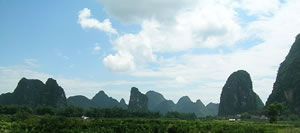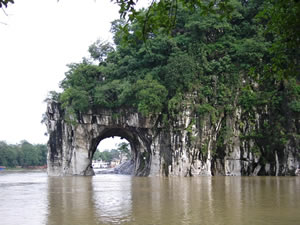The hills, which are often shrouded in mist or clouds, rise upwards from the plains alongside the Xi River.
They are spread out along 48km (30mi) of the river, soaring to heights of 100m (330ft) or more, and are studded with craggy outcrops, vertical fissures and parallel ledges of rock, where stunted trees with dark green foliage precariously survive.
 Long, sturdy vines trail from the branches of the trees, either dangling their tendrils over cliffs or else creeping over rocks. Orchids and other wildflowers add bright splashes of color to the otherwise grey-green scenery.
Long, sturdy vines trail from the branches of the trees, either dangling their tendrils over cliffs or else creeping over rocks. Orchids and other wildflowers add bright splashes of color to the otherwise grey-green scenery.
Formation of the Guilin Hills
 Around 300 million years ago, the area in which the Guilin Hills were formed was covered by an ocean with a bed of a tough, resistant rock known as quartzite. Over succeeding millennia, layers of sediment were deposited on top of the quartzite.
Around 300 million years ago, the area in which the Guilin Hills were formed was covered by an ocean with a bed of a tough, resistant rock known as quartzite. Over succeeding millennia, layers of sediment were deposited on top of the quartzite.
At first, the deposits consisted of fine mud, which become converted into a deep layer of shale as time progressed. Later sediments contained large concentrations of calcium carbonate, which were gradually transformed into limestone.
Upheavals in the Earth's crust caused the ocean floor to rise above the level of the sea, at once exposing the thick layers of limestone to the erosive power of the elements. Vast quantities of soft, porous limestone were dissolved and washed away, leaving behind the more resistant pinnacles to tower above the plain.
Caves
The Guilin landscape is one of the most notable examples of tower karst, a landform based on limestone that is full of caves, underground streams and passageways.
The architecture of the Guilin region has been created by rainwater made slightly acidic by the addition of carbon dioxide from the air. As rain falls, minute amounts of the carbon dioxide become dissolved in it, so that the rain turns into a weak solution of carbonic acid.
The acidic water works its way into any crack, fault or fissure in the rock and etches away the limestone. Little by little, the openings are widened into passages or caves and initial trickles of water become streams.
Acid rain is abundant around Guilin, where the average annual rainfall is between 1.1m (3.6ft) and 2.8m (9.2ft). The subtropical humidity and warmth - the average July temperature is 26°C (79°F) - maximize the chemical power of the water is maximized.
Rainwater that falls on the region also carries away calcium salts dissolved from the rocks. As the limestone-rich water seeps through the roofs of many caves, calcium carbonate is deposited in the form of stalactites and stalagmites.